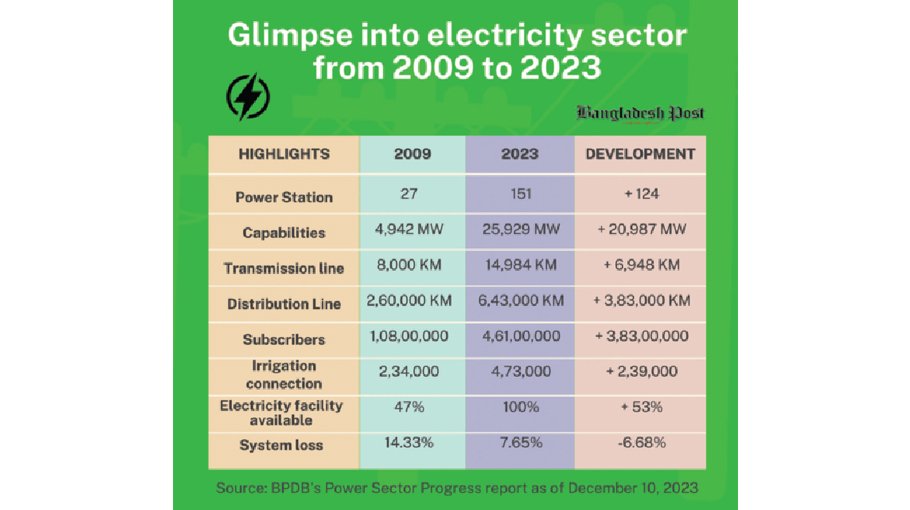Towards lighting up lives
Power sector milestones

In a transformative journey spanning 2009 to 2023, Bangladesh's electricity sector has achieved remarkable milestones, catapulting the nation into a new era of power generation and distribution.
According to the latest data from the Bangladesh Power Development Board's Power Sector Progress report as of December 10, 2023, the progress is nothing short of extraordinary.
A decade ago, in 2009, Bangladesh boasted 27 power stations. Fast forward to 2023, and the nation now proudly hosts 151 power stations, showcasing an impressive cumulative progress of +124. This surge in infrastructure underscores a concerted effort to meet the burgeoning energy demands of a growing population.
The evolution is not just in numbers but in capacity. In 2009, the nation's power generation capabilities stood at 4,942 MW. Today, that figure has skyrocketed to an impressive 25,929 MW, marking a cumulative progress of +20,987 MW. This robust expansion reflects a commitment to not only meet current energy needs but to prepare for future demands.
The intricate web of transmission lines, the lifelines of power distribution, has also seen substantial growth. From 8,000 KM in 2009, the transmission lines have expanded to cover 14,984 KM by 2023, showcasing a cumulative progress of +6,984 KM. This expansion signifies a concerted effort to improve the efficiency of electricity distribution across the nation.
The heart of any power sector lies in its ability to reach the farthest corners of its populace, and Bangladesh has excelled in this regard. Distribution lines, stretching 260,000 KM in 2009, now crisscross the nation for a total length of 643,000 KM in 2023. This staggering cumulative progress of +383,000 KM signifies an extensive effort to bring electricity to a broader consumer base.
The power grid is not just about numbers; it's about people. In 2009, Bangladesh had 10.8 million subscribers. Today, that number has surged to an impressive 46.1 million, reflecting a cumulative progress of +35.3 million. This surge underscores the growing accessibility of electricity services to an ever-expanding population.
Agriculture, a backbone of Bangladesh's economy, has also felt the positive currents of progress. Irrigation connections, vital for supporting agricultural activities, have grown from 234,000 in 2009 to 473,000 in 2023, showcasing a cumulative progress of +239,000.
Perhaps one of the most significant achievements is the attainment of 100% electricity facility availability in 2023, up from 47% in 2009. This milestone ensures uninterrupted power supply throughout the nation, a vital catalyst for economic growth and development.
Efficiency has been the buzzword in Bangladesh's power sector evolution. In 2009, distribution system losses stood at 14.33%. Today, the nation proudly boasts a reduced figure of 7.65%, marking a cumulative progress of -6.68%. This reduction in losses underscores a commitment to improving the overall efficiency of the distribution network.
In a remarkable turn of events, Bangladesh's power sector has soared to unprecedented heights, marking a significant surge in power generation capacity, widespread electrification, and a pronounced emphasis on renewable energy sources.
A PDPB official told Bangladesh Post that the nation's power landscape is now adorned with notable achievements that underscore its commitment to meeting the escalating energy demands of its people.
As per the government's Vision 2030, Bangladesh aspires to reach an electricity generation of 40,000 megawatts, with an ambitious target of 60,000 megawatts by 2041. The installation of an impressive 58 lakh 61 thousand 524 pre-paid meters further empowers consumers to manage their electricity usage efficiently.
According to sources, the nation has embraced renewable energy with the installation of 60 lakh solar home systems, contributing to a cleaner and more sustainable energy mix. In a commitment announced at the COP-26 summit, Bangladesh aims to increase its electricity generation from renewable sources to 40% by 2041, with the current renewable energy sector contributing 1,195 megawatts.
The power sector has witnessed significant investment, amounting to $32.60 billion over the last 15 years. Additionally, Bangladesh imports 2,656 megawatts of electricity from India, showcasing collaborative efforts in the region. Engaging actively with regional and international initiatives such as SAARC, SASEC, BBIN, BIMSTEC, and UN-ESCAP, Bangladesh is fostering cooperation in electricity import-export and cross-border transactions.
Embracing cutting-edge technology, the power sector has incorporated modern solutions such as pre-paid meter installations, GIS, ERP, SCADA, and Smart Grid automation, accelerating the pace of development.
Looking ahead, the government envisions incorporating innovative technologies like Hydrogen and Ammonia to produce sustainable electricity, as indicated on the Powercell website.
As Bangladesh continues to lead the region in pursuing a better, greener future, it is positioning itself as a pioneer in innovation and energy infrastructure investment, according to Dr. SM Nasif Shams, Associate Professor and Director of the Institute of Energy, University of Dhaka, who spoke with Bangladesh Post. This accomplishment, which was made possible by strategic vision and teamwork, represents a turning point in Bangladesh's transition to a more accessible and sustainable energy landscape.
As Bangladesh celebrates this decade-long journey, the nation stands as a testament to what strategic planning, investment, and dedication can achieve in transforming a crucial sector. The electrifying journey from 2009 to 2023 is not just about the numbers on paper; it's about lighting up lives, empowering industries, and propelling the nation towards a brighter, more sustainable future.



